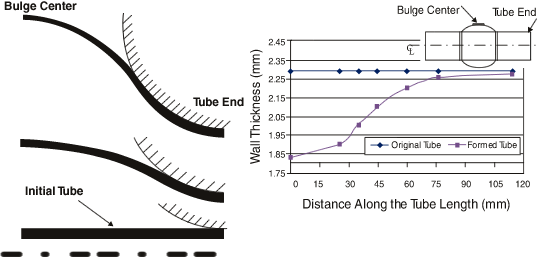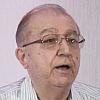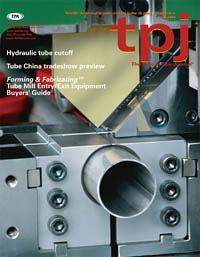Engineer and Bicycle Products Manager
- FMA
- The Fabricator
- FABTECH
- Canadian Metalworking
Categories
- Additive Manufacturing
- Aluminum Welding
- Arc Welding
- Assembly and Joining
- Automation and Robotics
- Bending and Forming
- Consumables
- Cutting and Weld Prep
- Electric Vehicles
- En Español
- Finishing
- Hydroforming
- Laser Cutting
- Laser Welding
- Machining
- Manufacturing Software
- Materials Handling
- Metals/Materials
- Oxyfuel Cutting
- Plasma Cutting
- Power Tools
- Punching and Other Holemaking
- Roll Forming
- Safety
- Sawing
- Shearing
- Shop Management
- Testing and Measuring
- Tube and Pipe Fabrication
- Tube and Pipe Production
- Waterjet Cutting
Industry Directory
Webcasts
Podcasts
FAB 40
Advertise
Subscribe
Account Login
Search
Hydroforming tapered engineered tubes
Are they more formable than uniform-thickness tubes?
- By Chuck Smith, Taylan Altan, Ph.D., Prashant Soman, Serhat Kaya, and Yingyot Aue-u-lan
- June 8, 2004
- Article
- Hydroforming
In tube hydroforming processes, tube is expanded by a high-pressure medium (usually water) until it fills a die cavity. Since the volume of tube material (the product of its cross section multiplied by its length) remains constant, the tube wall thins to accommodate the expansion. Often axial feeding is used to reduce wall thinning, but this is not always possible. In such cases, other efforts are made to reduce wall thinning to produce a hydroformed component with nearly uniform wall thickness along its length. Research conducted at the Engineering Research Center for Net Shape Manufacturing (ERC/NSM) examines the use of extruded aluminum tubes that vary in thickness both circumferentially and axially for these purposes.1
 |
| Figure 1 (Left) An FEA model at intermediate stages of forming simulation of a uniform-thickness tube shows that the wall remains thick at the tube end but thins in the bulge area. The most dramatic thinning is at the bulge center. (Right) Measuring the tube's wall thickness along its length after bulging shows that the wall thinned from 2.30 mm to less than 1.85 mm at the bulge center. The material is 6061 T4 aluminum; OD = 64.135 mm, length = 230 mm, to= 2.30 mm. |
 |
| Figure 2 A simple engineered tube has gradual changes in wall thickness. |
The hydraulic bulge test was used to investigate the wall thinning that occurs during hydroforming.2In this test, the tube is sealed at both ends and pressurized until it bursts. The tube is formed freely at the midsection (middle of the bulge). Figure 1(left) shows the deformation stages in the hydraulic bulge test, and the right side of Figure 1 shows that maximum thinning occurs at the center of the bulge.
This hydroforming study, which evaluated the formability limits of tapered tubes as compared to tubes of uniform wall thickness, includes both a description of the methodology used to evaluate various engineered tube designs and a comparison of simulation versus experimental results. Five engineered tube designs were analyzed by finite element analysis (FEA). Two engineered tubes—those that appeared to provide the most uniform wall thickness in bulging—were selected and tested experimentally.
What Is An Engineered Tube?
 |
| Figure 3 Engineered tube concept D has specific steps where the tube wall changes from constant thickness to increasing thickness. |
Tubes with varying wall thickness along the length are known as butted or engineered tubes (see Figure 2). Tubes that have varying thickness circumferentially and an asymmetrical cross section also are called engineered tubes. 3
Engineered aluminum tubes commonly are used for manufacturing structural frames for bicycles. Worth Applied Products Inc. manufactures engineered aluminum tubes using a proprietary technique. Engineered tubes can be designed based on the deformation profile of the expansion during hydroforming. In other words, in the tubular preform, the location of the largest deformation is made thicker. This helps to produce a hydroformed part that has more uniform wall thickness; it also reduces the overall weight of the part.
Conceptual Design of Engineered Tubes
 |
| Figure 4 Engineered tube concept E has several gradual changes in wall thickness. |
Five conceptual designs were proposed.4Of these five (designated A through E), the two that were determined by FEA to have the most potential were concept D, which has a linear wall thickness increase, and concept E, which has a stepped wall thickness increase (see Figure 3).
The concept E tube was prepared by following the wall-thinning distribution pattern of the deformed tube shown in Figure 1. The region of maximum wall thinning after deformation was reinforced with more material in the longitudinal direction. Figure 4 shows the schematic drawing of this tube design concept.
Evaluation of Engineered Tubes
Two criteria were used to evaluate the engineered tubes: maximum bulge height at bursting pressure and wall thickness uniformity. To determine the maximum bulge height at bursting pressure, researchers pressurized two tubes of each design until they burst. To find the wall thickness uniformity at the deformation area, they tested two tubes of each design at 15 percent expansion. The thickness distribution along the longitudinal direction was measured with a digital micrometer.
 |
| Figure 5 The maximum bulge height before rupture is lowest for a uniform-thickness tube and highest for engineered tube E. |
Finding the Formability Limit. Each tube was pressurized until bursting. Figures 5 and 6 show the comparison of the maximum bulge heights and the maximum percentage of wall thinning measured for concept D and concept E tubes, respectively.
According to the experimental results, the maximum bulge heights achieved at fracture were approximately in the same range for all the tube designs. However, the concept E tube provided a 1.2-mm higher bulge height (compared to the initially uniform wall thickness of the tube). This 1.2-mm higher bulge height equated to an increase in expansion of 15 percent to 18 percent.
Quantifying the Uniformity of Deformed Tubes. After the experiments, the thickness distributions of concepts D and E were measured, as shown in Figure 7. The results show that, as predicted in the simulations, engineered tube E results in more uniform thickness than engineered tube D. Figure 7 shows the comparison of thickness measurements of engineered tubes D and E, obtained experimentally and by FEA.
 |
| Figure 6 The percentage of wall thinning in the three tubes – one of uniform thickness and concepts D and E – correlates to the maximum bulge height in Figure 5. The uniform-thickness tube has the greatest percentage of wall thinning; engineered tube design E has the least. |
The thickness variation trends calculated by simulations match those measured in experiments. However, the simulations underestimated the thickness values. This is thought to be caused by an erroneous assumption: The tube material used in the simulation model was assumed to be isotropic, that is, having uniform properties throughout. However, in reality aluminum alloys show significant anisotropic behavior; the properties along one axis are different from the properties along another axis. Figure 8 shows the thickness variation observed in engineered tube E at the bulge height of 3.80 mm (without bursting). Uniform thickness distribution was achieved in the deformation area.
Conclusions
Using FEA to predict results and hydraulic bulge tooling to measure actual experimental results facilitated the evaluation of formability limits of engineered tubes (with variable wall thickness in the axial direction) as compared with uniform-thickness tubes during hydroforming. The conclusions drawn from the experiments are:
 |
| Figure 7 The discrepancies between the simulated prediction and experimental results are slight—less than 0.1 mm for both concept D and E. |
1. The percentage of wall thinning cannot be used as a criterion for determining the amount of deformation that will occur in one engineered tube design versus another engineered tube design.
2. Uniformity of wall thickness can be used as a criterion to evaluate a tube's performance in hydroforming.
3. Using an engineered tube can increase the weight of a component. This weight increase is minimized by increasing the wall thickness in high-deformation areas and decreasing it in the guiding zones, or ends, of the component, where no deformation occurs.
4. In selected applications, engineered tubes that have varying wall thickness in the axial direction may offer advantages in tube hydroforming by allowing more expansion and less total weight.
 |
| Figure 8 Engineered tube E achieved uniform thickness distribution in the bulged area at 13 percent tube expansion without fracture. |
Yingyot Aue-u-lan, Prashant Soman, and Serhat Kaya are graduate research associates, and Taylan Altan, Ph.D., is a professor and the director of ERC/NSM at The Ohio State University, 339 Baker Systems, 1971 Neil Ave, Columbus, OH 43210, 614-292-5063, fax 614-226-7219, altan.1@osu.edu, www.ercnsm.org. Chuck Smith is the bicycle projects manager and engineer at Worth Applied Products Inc., 2100 N. Jackson St., Tullahoma, TN 37388, 931-455-0691 ext. 272, fax 931-454-0536, csmith@worthsports.com, www.worthsports.com.
Notes
1. S. Kaya and T. Altan, "Formability of Engineered Extruded Aluminum Profiles," THF/ERC/NSM/01-R-52, The Ohio State University, Columbus, Ohio, 2002.
2. Y. Aue-u-lan, M. Strano, and T. Altan, "Determination of Flow Stress and Formability of Tubes for Hydroforming," THF/ERC/NSM/00-R-11, The Ohio State University, Columbus, Ohio, 2000.
3. Ibid.
4. P. Soman, Y. Aue-u-lan, S. Kaya, and T. Altan, "Investigation of Formability of Engineered Tubes," THF/ERC/NSM/03-R-32, The Ohio State University, Columbus, Ohio, 2003.
About the Authors
Chuck Smith
2100 N. Jackson St.
Tullahoma, TN 37388
931-455-0691

Taylan Altan, Ph.D.
Professor Emeritus and Director - Center for Precision Forming
Prashant Soman
Production Engineer
7145 Commerce Blvd.
Canton, MI 48187
734-207-7263
Serhat Kaya
Graduate Research Assistant, ERC/NSM
1971 Neil Ave. Baker Systems Engineering, Room 339
Columbus, OH 43210
614-292-9267
Yingyot Aue-u-lan
Graduate Research Assistant, ERC/NSM
1971 Neil Ave. Baker Systems Engineering, Room 339
Columbus, IN 43210
614-292-9267
About the Publication
Related Companies
subscribe now

The Tube and Pipe Journal became the first magazine dedicated to serving the metal tube and pipe industry in 1990. Today, it remains the only North American publication devoted to this industry, and it has become the most trusted source of information for tube and pipe professionals.
start your free subscription- Stay connected from anywhere

Easily access valuable industry resources now with full access to the digital edition of The Fabricator.

Easily access valuable industry resources now with full access to the digital edition of The Welder.

Easily access valuable industry resources now with full access to the digital edition of The Tube and Pipe Journal.
- Podcasting
- Podcast:
- The Fabricator Podcast
- Published:
- 04/16/2024
- Running Time:
- 63:29
In this episode of The Fabricator Podcast, Caleb Chamberlain, co-founder and CEO of OSH Cut, discusses his company’s...
- Trending Articles
Team Industries names director of advanced technology and manufacturing

Orbital tube welding webinar to be held April 23

Chain hoist offers 60-ft. remote control range

Push-feeding saw station cuts nonferrous metals

Corrosion-inhibiting coating can be peeled off after use

- Industry Events
16th Annual Safety Conference
- April 30 - May 1, 2024
- Elgin,
Pipe and Tube Conference
- May 21 - 22, 2024
- Omaha, NE
World-Class Roll Forming Workshop
- June 5 - 6, 2024
- Louisville, KY
Advanced Laser Application Workshop
- June 25 - 27, 2024
- Novi, MI


























